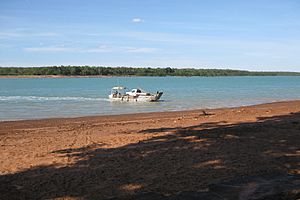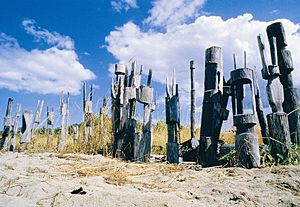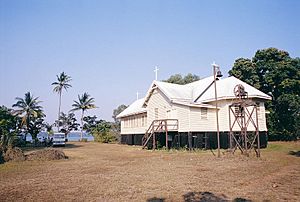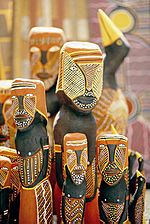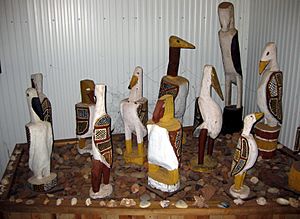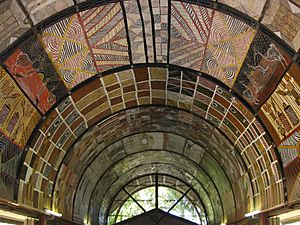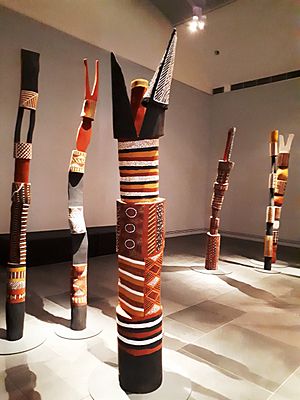Tiwi Islands facts for kids
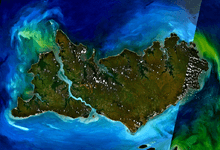
Landsat 7 imagery of the Tiwi Islands.
|
|
| Geography | |
|---|---|
| Location | Arafura Sea |
| Coordinates | 11°36′S 130°49′E / 11.600°S 130.817°E |
| Total islands | 11 |
| Major islands | Melville Island Bathurst Island |
| Area | 8,320 km2 (3,210 sq mi) |
| Coastline | 1,016 km (631.3 mi) |
| Administration | |
|
Australia
|
|
| State or territory | Northern Territory |
| LGA | Tiwi Islands Region |
| Demographics | |
| Population | 2,453 (2016) |
| Languages | Tiwi |
| Ethnic groups | Tiwi |
| Additional information | |
 Flag |
|
The Tiwi Islands are a group of islands in the Northern Territory, Australia. Their name, Ratuati Irara, means "two islands" in the local Tiwi language. These islands are located about 80 kilometers (50 miles) north of Darwin, near the Timor Sea.
The group includes two large islands, Melville Island and Bathurst Island. There are also nine smaller islands that no one lives on. Together, they cover an area of about 8,320 square kilometers (3,212 square miles).
The Tiwi people have lived on these islands for thousands of years. They are an Aboriginal Australian group. In 2016, about 2,453 people lived on the Tiwi Islands.
The Tiwi Land Council helps manage the land for the Tiwi people. It works to protect their land rights and traditions.
Contents
Geography and People
The Tiwi Islands formed after the last ice age ended, about 11,700 years ago. The sea level rose and flooded the land, creating the islands. Tiwi traditional stories tell about this flooding, passed down through generations.
The islands are north of mainland Australia. They are surrounded by the Timor Sea to the north and west. To the south, you'll find the Beagle Gulf, Clarence Strait, and Van Diemen Gulf. The Dundas Strait is to the east.
The two main islands are Melville and Bathurst. Melville Island is Australia's second-largest island. Bathurst Island is the fifth-largest. The nine smaller islands are Buchanan, Harris, Seagull, Karslake, Irritutu, Clift, Turiturina, Matingalia, and Nodlaw.
The Apsley Strait separates Melville and Bathurst Islands. This strait is about 62 kilometers (38 miles) long. It connects Saint Asaph Bay in the north to Shoal Bay in the south. A car ferry helps people travel between the two main islands.
The Tiwi people have lived here for thousands of years. They are different from other Aboriginal groups on the mainland. In 2016, 89% of the island's population were Aboriginal or Torres Strait Islander people.
Most people on the islands speak Tiwi as their first language. They also speak English.
Most residents live in three main towns:
- Wurrumiyanga (on Bathurst Island)
- Pirlangimpi (on Melville Island)
- Milikapiti (on Melville Island)
Wurrumiyanga is the largest town, with almost 1,500 people. The other two towns each have about 450 people. There are also smaller communities like Wurankuwu.
History of the Islands
Aboriginal people have lived in the Tiwi Islands area for at least 40,000 years. Their creation stories mention their presence on the islands from about 7,000 years ago.
Tiwi islanders may have traded with Macassan people from Indonesia long ago. The first time Europeans recorded visiting was in 1705. Dutch explorers landed on Melville Island. Other explorers from France and Britain visited in the 1700s and 1800s.
In 1824, Captain Gordon Bremer from Britain set up the first European settlement in northern Australia. It was called Fort Dundas on Melville Island. But the Tiwi people were not happy about it. The settlement was abandoned after only five years in 1829.
Later, the Tiwi Islands became part of the New South Wales colony. Then, in 1863, they were controlled by the Colony of South Australia. Finally, in 1911, the islands became part of the federal government's Northern Territory.
In 1911, a German Catholic missionary named Francis Xavier Gsell started a mission on Bathurst Island. This mission brought education and welfare services. However, it also tried to stop the use of Aboriginal languages and culture. Today, the Catholic church in Wurrumiyanga has beautiful Tiwi artwork.
Control of the islands was given back to the Tiwi people through the Tiwi Aboriginal Land Trust. The Tiwi Land Council was started in 1978 to represent them. In 2008, the Tiwi Islands Shire Council was formed to manage local government.
Government and Administration
The Tiwi Islands are part of Australia's federal electorate of Lingiari. They are also part of the Northern Territory's electorate of Arafura.
The islands are managed by the Tiwi Islands Regional Council. This council has 12 members elected from four areas:
- Milikapiti Ward (northeast Melville Island)
- Nguiu Ward (south Bathurst Island, Buchanan Island)
- Pirlangimpi Ward (west and southwest Melville Island)
- Wurankuwu Ward (north Bathurst Island)
The Tiwi Land Council also plays a big role in managing the land for the Indigenous people.
Culture and Art
Creating Indigenous Australian art is a very important part of Tiwi Island culture. It also helps the local economy. There are three main art centers on the islands: Tiwi Design, Munupi Arts & Crafts, and Jilamara Arts and Craft. They work together as Tiwi Art.
Other art groups include Bima Wear, which makes fabric designs and clothing. Ngaruwanajirri is another important art center.
Many Tiwi artists have shown their work around the world. Their art is also in major Australian collections. Some famous Tiwi artists include Kitty Kantilla and Jean Baptiste Apuatimi.
Tiwi people often carve wooden birds. These carvings are displayed in places like the Mission Heritage Gallery. The birds represent different parts of Tiwi mythology. Some birds tell people about the coming monsoon rains. Others warn of cyclones. Some represent ancestors who turned into birds. Carved birds are sometimes placed on top of special burial poles called tutini.
Tiwi artists also create designs on fabric. They often use a method similar to Indonesian batik, where wax is used to create patterns. They make beautiful silk scarves and other items.
Art creation is often a social activity. Groups of people sit together, talk, and work in a relaxed way. Sometimes, these groups are separated by gender.
Pukamani Ceremony
The Pukamani ceremony is a special burial ceremony for the Tiwi people. It is based on a Dreamtime story. This ceremony happens around carved and painted grave posts called tutini.
The ceremony takes place two to six months after someone has passed away. It can last for a few days. Artists carve and paint up to 12 tutini, which are placed around the grave. These poles are made from ironwood and decorated with natural colors.
Dancers move among the tutini during the ceremony. At the end, painted bark baskets called Tunga are placed on top of the posts. The burial poles are left to slowly decay. They are seen as gifts to please the spirits of the dead.
These poles are important cultural objects. Sometimes, specially made poles are shown in art galleries around Australia and the world.
Music
The band B2M (Bathurst to Melville) is from the Tiwi Islands. They have toured places like Taiwan and played at the Barunga Festival.
Sport on the Islands
Australian Rules Football
Australian rules football is the most popular sport on the Tiwi Islands. Missionaries brought the sport here in 1941. The Tiwi Islands Football League has been running since 1969.
About 900 people out of 2,600 play football on the islands. This is one of the highest participation rates in Australia! The Grand Final of the Tiwi Islands Football League happens every March. It attracts up to 3,000 spectators.
Tiwi footballers are known for their amazing skills. Many players prefer to play barefoot. Many male players also play for the St Mary's Football Club in Darwin.
The Tiwi Bombers Football Club joined the Northern Territory Football League in 2006.
Many famous footballers from the Tiwi Islands have played in Australia's top league, the AFL. These include Maurice Rioli, Cyril Rioli, and Michael Long. Maurice, Michael, and Cyril have all won the Norm Smith Medal. This award goes to the best player in an AFL Grand Final.
Cricket
In 2010, Australian cricketers like Mathew Hayden helped raise money for cricket on the Tiwi Islands. They raised $200,000 for the sport. A special cricket match drew about 1,000 people, nearly half the island's population.
Transport
Fly Tiwi offers commercial flights connecting the islands to each other and to Darwin. They have daily flights to the three main communities.
SeaLink NT runs ferry services between Wurrumiyanga and Darwin. The trip takes about 2.5 hours each way, three days a week.
In 2008, the local government looked after 925 kilometers (575 miles) of roads on the islands.
Environment and Nature
The Tiwi Islands have unique plants and animals. This is because they are isolated and get a lot of rain. Many species found here are not seen anywhere else in the Northern Territory, or even the world.
The islands have tall eucalypt forests. They also have many rainforests.
Climate
The Tiwi Islands have a tropical monsoon climate. This means they get a lot of rain. The wet season is from November to April. This is when the islands get the most rainfall in the Northern Territory.
The Tiwi people describe three distinct seasons:
- The dry season (season of smoke)
- The buildup (high humidity and cicada songs)
- The wet season (storms)
These seasons guide the Tiwi people's way of life. They affect what food is available and when ceremonies happen.
Plants and Animals
The islands have been separated from mainland Australia since the last Ice Age. They are mostly covered with eucalypt forests. These forests have trees like Darwin Stringybarks and Woollybutts. There are also small rainforests near freshwater springs. Mangroves grow in the many inlets.
The Tiwi Islands are home to many rare and unique species. Thirty-eight threatened species have been recorded here. Some plants and insects are found nowhere else. This includes eight plant species and some snails and dragonflies.
Threatened mammals include Brush-tailed rabbit rats and northern brush-tailed phascogales. The islands also have the world's largest breeding colony of crested terns. A large number of vulnerable olive ridley turtles live here too. The seas around the islands have different types of sharks and saltwater crocodiles.
Important Bird Area
BirdLife International has named the Tiwi Islands an Important Bird Area (IBA). This is because many important birds live here. These include red goshawks and partridge pigeons. Up to 12,000 great knots, which is over 1% of the world's population, also visit.
Other important birds include chestnut rails and rainbow pittas. Many birds here are unique to the islands. For example, the Tiwi Australian masked owl is considered endangered. The Tiwi hooded robin is also endangered and might even be extinct.
Forestry and Mining
Forest products are important for the Tiwi Islands' economy. Tree plantations have been grown here since the 1950s. In 2001, a large project started to grow Acacia mangium trees for woodchips.
The islands also have mineral sands on Melville and Bathurst Islands. In 2007, mining started to export zircon and rutile to China. However, mining operations stopped in 2008.
In 2020, a company managing acacia trees on the islands delayed harvesting. This was because demand for woodchips in China was low due to the COVID-19 pandemic.
See also
 In Spanish: Islas Tiví para niños
In Spanish: Islas Tiví para niños




